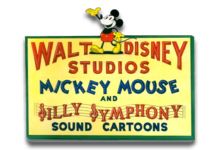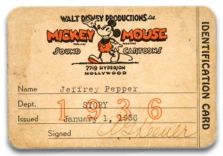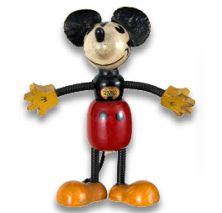Midways and rollercoasters. Funhouses and penny arcades. These types of amusements have long been considered the antithesis of Disney-based entertainment. Piers, parks and carnivals represented the entertainment dynamic Walt Disney sought to avoid when he created Disneyland. Yet his animators had drawn inspiration from such settings, and contemporary Imagineers have revisited these more traditional amusement venues in recent theme park conceptualizations.
While not necessarily roadside attractions in the traditional sense, amusement piers and boardwalks still relate rather closely to the mid-20th century popular culture influences we have been studying in the Roadside Disney series.

Ironically, the most obvious and certainly most elaborate execution of this theme was in a production based in fantasy, rather than reflecting a contemporary cultural setting. While Disney's second animated feature
Pinocchio was drawn from Carlo Collodi's children's story, the film's penultimate sequence on Pleasure Island owed its visual direction and design sensibilities to amusement parks and carnivals. In Collodi's original story, Pinocchio accompanies his friend Candlewick to "the land of Boobies," where they engage in unspecified play and frolic before transforming into donkeys. Disney and his artists expanded this somewhat ambiguous setting into Pleasure Island, a full-blown amusement park, replete with rides, games and carnival food that veered distinctly away from the story's 19th century Italian folktale origins.

The sequence played to the seedier side of amusement and carny operations--drinking, smoking, carousing and fighting, serving to bring about the jackass transformations of Pinocchio and Lampwick. It was effective, yet it more reflected then-contemporary Americana and was in direct contrast to the film's otherwise European look and feel. The design of Pleasure Island was clearly rooted in real world amusement parks from the early decades of the 20th century. Coney Island's Luna Park, Dreamland and Steeplechase Park establishments were likely among the artists' inspirations.

One of the attractions common to amusement parks was the penny arcade. A popular place filled with pinball, claw and digger machines and Mutoscope movies, an arcade was a popular destination at boardwalks, piers and other similar locations. In 1941, Disney cartoon makers translated the penny arcade into animated form in the Donald Duck short
A Good Time for a Dime. Drawing on amusement park architecture, the short opens with Donald standing at the entrance to an arcade, its talking clown facade inviting him inside. Animators had employed similar oversize "architectural barkers" in their designs for Pleasure Island in
Pinocchio. It was a style common to early amusement park establishments, and likely also inspired in part by Steeplechase Park's broadly caricatured and iconic "funny face" that was that park's trademark and mascot for many years.

Throughout the late 1940s and early 1950s, the Disney Studios produced a number of cartoons that featured oceanfront settings. Southern California was home to quite a few amusement piers, so it was only natural that animated incarnations of these beachside "fun zones" ultimately played host to the likes of Goofy and Donald Duck and his nephews.

In 1947, background artist Thelma Witmer created an amusement pier setting for the Donald Duck cartoon
Straight Shooters. While many would likely consider the

background to be a fairly generic representation of an amusement setting, the rendering bore a striking resemblance to the Venice Beach amusement pier in Venice, California. That Fun Zone's Bamboo Slide is clearly featured in cartoon form, as is the rollercoaster that long occupied a location at the very end of the pier. Operated by the Kinney family, the pier reached its peak of popularity in the 1920s when it attracted several hundred thousand visitors on busy weekends. By the time Disney produced
Straight Shooters in the mid-1940s, the pier's popularity had waned and civic and political forces brought about its demolition.
In
Straight Shooters, animators made sport of one of the most negative of amusement park archtypes, the dishonest and frequently scamming midway pitchman. Donald naturally assumes that particular role, and subsequently sets the stage for a showdown between himself and his ever resourceful nephews Huey, Dewey and Louie.

The background painting in
Straight Shooters would go on to be recycled for two other animated shorts. In
Hold That Pose, released in 1950, Goofy is sidetracked from the zoo to a fun zone when he leads his photographic quarry, a bear, on a merry chase through a funhouse, a rollercoaster and other assorted amusement park trappings. A few years later, George Geef's day at the beach with his son Junior in the Goofy cartoon
Father's Weekend ultimately takes him to the same amusement pier. Sailors on shore leave frequently haunted the piers and this is reflected in Geef's tunnel of love encounter and also his inadvertent visit to a tattoo parlor. It is interesting to note that the narrator of
Father's Weekend specifically calls the amusement area the "Fun Zone," the same name given to the midway on the Venice Beach pier.

Midway hucksters and tattoo parlors were just a couple of the less than savory elements associated with the amusement piers, and those and similar negative associations served to inspire Walt Disney to build a more family-friendly amusement establishment in the form of Disneyland. It therefore should not have been surprising to Disney management and Imagineers that their concept for the Paradise Pier area of Disney's California Adventure that debuted with that park in 2001, was greeted criticism from many Disney theme park enthusiasts. Bright, colorful and clean, the area captured the nostalgia and thrills of traditional amusement venues while jettisoning the seedier

elements long associated with such places. Much in the way Main Street U.S.A. is an idealized manifestation of turn-of-the-century American life that skillfully eliminated the saloons and muddy thorofares common to small towns of that era, Imagineers cleaned up and re-imagined the amusement pier in the same manner. What was formerly without theme became a theme unto itself. It is a concept not entirely without controversy; acceptance is generally contingent upon the level of nostagia a given individual feels for the amusement park dynamic. Most visitors to Paradise Pier take no offense. Others reject it out of hand, citing the very overused and often intangible notion of Walt Disney's half a century removed disapproval.
The style and design of amusement establishments is in many ways an architectural cousin to California Crazy, which we featured in an earlier Roadside Disney article. Though programmatic architecture is most closely associated with roadside landscapes, it had a parallel evolution in amusement park settings where its often outlandish designs were generally more appropriate. In
Pinocchio, Pinocchio and Lampwick sojourn to a pool hall that exists in the form of a giant-sized eight ball. The Venice Pier-inspired background from the shorts features a sphinx facade. Paradise Pier's Orange Stinger swing ride is enclosed in oversized citrus fruit.
 Epcot is literally exploding with life and color thanks to the 2008 International Flower and Garden Festival. Pluto proves that's its sometimes all right to let a dog in the garden. Nearby, Tic Tok is just one of the stunning elements of a horticultural vignette themed to Neverland and the characters from Peter Pan.
Epcot is literally exploding with life and color thanks to the 2008 International Flower and Garden Festival. Pluto proves that's its sometimes all right to let a dog in the garden. Nearby, Tic Tok is just one of the stunning elements of a horticultural vignette themed to Neverland and the characters from Peter Pan.


































































